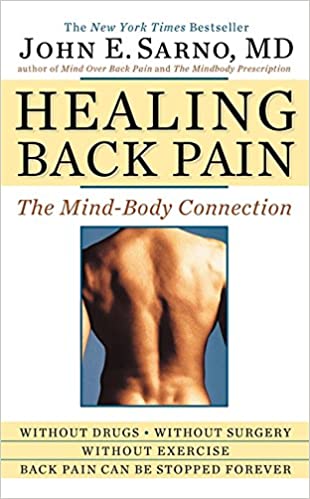The journey of healing comes with an essential task of forgiving.
So, the first step is to allow yourself to have the feelings without resisting it, venting it, fearing it, condemning it or moralizing about it.
Forgiving means to drop judgment and to just see that it is just a feeling.
The technique is to be with your feelings and to surrender all efforts to modify how you feel in any way.
Let go of wanting to resist the feeling.
It is the resistance that keeps the feeling going.
When you give up resisting or trying to modify the feeling it will shift to the next feeling and be accompanied by a lighter sensation.
A feeling that is not resisted will disappear… as the energy behind it dissipates over time.
Book Study: Healing Back Pain by Dr. John Sarno
Today we are continuing our book study starting off with number one on the list Healing Back Pain by the legendary Dr John Sarno.
I respect Dr. Sarno because the man put in some phenomenal work.
You know a lot of times we are going to encounter situations and people who we don’t agree with.
The key is to know when to let go and not be attached to the feeling that we need to explain ourself or convince the person of your position.
And it’s important to also stand your ground when you need to.
The Definition of Letting Go!
One thing that is very important to point out is that as we continue on one thing that will continue to come up is the definition of letting go.
I’m not going to quote it word for word but to summarize it…
The definition of letting go is pretty much, allowing yourself to feel what you feel and not trying to change it.
A lot of times during the healing journey people twist that a little bit.
They start to think that letting go probably because of the words themselves they could mean many different things for many different people.
However, the words letting go to a lot of people, they perceive it as just drop the feeling, you know?
Respect my Boundaries!
So if there’s a part of you that cares about being right, the letting go part isn’t let me just stop caring about being right but instead honoring that feeling, honoring that need and that desire to answer your question about what we do when there’s a disagreement.
A lot of times these types of things are situational.
It really depends on what the situation is and what’s happening but ultimately a good place to start, is shifting your focus from the need to convince this person that my point of view is correct too.
Are my boundaries being respected? Anyone can believe whatever they want to believe especially when the most hot topic is politics. Anyone can have whatever political views they want to have.
This is something I’m experiencing in my own personal life as well where friends or families have different political views and I’m perfectly okay with that but they start getting into shaming and trying to force their beliefs and you have to behave this way and you have to do these things…
That’s where I stop… time out.
I am not trying to change you, please don’t try to change me, okay?
I am not trying to change your beliefs, please don’t try to change my beliefs.
Don’t try to push your beliefs on me and as long as those boundaries are respected then we can have a beautiful relationship, a beautiful friendship.
Change your Focus!
So my answer to that is move your focus from coming forward, trying to prove your point, to holding your ground and respecting your boundaries.
These are my boundaries, okay?
When I don’t want to speak about that topic, let’s just focus on something else.
Then you insist once again, this is my boundary. I do not wish to go there. You’re a persistent one.
This is my boundary you know and if you have to repeat it over and over, this is my boundary, this is my boundary, this is my boundary, this is not open for a discussion.
This is my boundary; and yes unfortunately that’s how it is with some people, especially people having narcissistic tendencies.
It’s almost like they get aroused when they see a boundary because they just want to screw it up, you know they want to cross that boundary they want to see how far they can push the envelope and how much they can trigger you.
So if you’re dealing with someone who’s like that you it’s going to require lots and lots of repetition and lots and lots of self-control to not get sucked into their game.
You know that’s where I will start.
Move your focus from I’m trying to prove a point to what’s my boundary and am I holding my ground and you can start there, okay?
For some people healing their back pain may require taking a look at things like perfectionism and other things.
That kind of hover around that behavior and a lot of times, if of our passion is to excel and overachieve and overdo things, you’ll actually benefit more from being open to making mistakes and being open to being corrected.
It’s one way in which we grow as someone who is attempting to model behavior.
I just want to highlight that and hopefully serve as a model in the future when you stand corrected on a certain point.
TMS is a diagnosis for which the treatment is education fits right into this more modern way of thinking and we go around repeating that sentence.
So what is the treatment for TMS? It is not meditation.
It is my contention that the chronic pain epidemic could be reversed if more physicians and patients understood TMS in 1992.
The scientific community acknowledged the role of emotions in physical health when congress mandated the national institutes of health to open an office of complementary and alternative medicine.
This moved mind-body research and practice closer to the medical mainstream.
This mandate has stimulated government sponsored and privately funded research as well as added mind-body medicine to medical school curricula.
However psychosomatic medicine is still not being adequately taught to physicians other than psychiatrists and ironically it is the physicians such as internists, orthopedists, rheumatologists, gastroenterologists, dermatologists etc who must make the psychosomatic diagnosis before it can be adequately treated by a psychiatrist or a psychologist.
So we mentioned a few different professions where Dr Sarno is pretty much stranded saying it straightforward these professions and I’ll repeat it again.
We have an internist, orthopedist, rheumatologist, gastroenterologist and dermatologist who must make the TMS diagnosis before they can be referred to a psychiatrist or a psychologist.
So a lot of times people ask if I have psoriasis, will TMS healing work for me as well.
According to Dr Sarno one can only assume that the answer is yes. What about gastroenterologists?
So I have a lot of stomach issues, would TMS work for me too. Yes!
What about the rheumatologist.
I have this special type of arthritis, is it still TMS, is it still a mind-body thing. Yes. What about orthopedists; yes.
Furthermore, the modern healthcare system based, as it is on a rigorous corporate model, does not allow for adequate time to be spent with patients to elicit the basis for the symptoms and poses another impediment to stemming the tide of chronic pain.
So, our medical system is running on something called a corporate model and anyone here in corporate would like to explain what that means or even if you’re not in corporate, would you like to tell us a little bit what the corporate model is like, what does that mean and how does it get in the way of our health care?
Well you have to explain the second part because we have it here in the book but what does the corporate model mean?
It means every doctor has some type of quota they have to hit in order to be successful so they have to see as many patients as possible in a short amount of time as possible.
Yes, that’s the corporate model and it’s actually one of the main reasons why I dropped out of college;
I was literally sitting in class and my favorite class was of psychology and the professor, I don’t even remember his name.
The corporate model and how it gets in the way of psychotherapy and I wasn’t happy about it at all.
Here you don’t need a degree, you don’t need a license, you could just flat out tell people I am not a psychologist but I can help you with that and you’re okay.
If there’s a model that tells me I have to see more and more people in a certain number of times then how do we actually listen to what the person is saying and that’s exactly what Dr Sarno is saying.
The corporate model does not allow for adequate time to be spent with patients to elicit the basis for the symptoms and poses another impediment to stemming the tide of chronic pain.
During my professional life particularly over the last 50 years, the medical culture and that rewards specializations efficiency and hard data has forced the contemporary physician to distance himself from the patient, the clinical examination and the emotional status of the patient are often compromised and It is difficult for the contemporary physician to engage the patient in a conversation about life hopes, disappointments and ambitions.
Recently I connected with a gentleman the first time we spoke, he said my wife found you on the internet and I’m skeptical we can connect. I said yeah sure, let’s have a call.
We had a nice long talk and at the end of the conversation I said to him when you have a chance check out this movie and I sent them the link which is on Youtube for free to a movie called: Anatomy of an Illness
It’s the story of Norman Cousins who healed from right around the time that Dr. Sarno was starting his observations in the 60s or 70s.
You know, just make it a family movie night.
Watch the movie and they’ll give you some idea of what’s happening there and he says unbelievable.
“I asked my doctor so many questions and he couldn’t give me a straight answer.”
That’s so frustrating; well it’s not the doctor’s fault and in my practice I’ve worked with many doctors and the corporate model at least in the time that this book was written; today things are shifting little by little but the corporate model does get in the way of exactly what Dr Sarno wrote here.
I’ll read it again it says the clinical examination and the emotional status of the patient are often compromised and it is difficult for the contemporary physician to engage the patient in a conversation about life hopes, disappointments and ambitions.
So many patients share horror stories that their doctor got pissed off and didn’t want to hear anything about the mind body stuff.
Let’s not blame the doctor because unfortunately the bigger issue is the establishment and again that’s shifting little by little so at the end of the day it’s more about how we take responsibilities for ourselves.
Now moving on as this trend in contemporary medical culture has taken hold, physicians are still not trained to recognize psychosomatic disorders.
They are trained to explain all physical disorders with physical structural reasons and therefore not to consider the role of emotions in the ideology of physical disorders.
As a consequence patients with back pain do not receive appropriate treatment, which would mandate paying attention to emotional phenomena.
According to contemporary diagnostics, physical disorders are purely the consequence of structural, physical maladies.
Therefore, psychosomatic ideology has no role in the diagnosis of pain disorders and the physicians training continues to associate medical practice with matters of the body exclusively the patient is viewed as a machine controlled by several systems emitting the person’s psychology entirely as one of those systems.
This omission in the physician’s portfolio has been a leading factor in the epidemiological increase of pain disorders.
That’s a long one when I wrote about healing back pain, my intention was to describe a very common almost universal pain disorder to professionals and the public.
I never anticipated that merely reading the book would relieve so many patients of their pain.
Yet I continue to receive communications from all over the world reporting that reading the book was sufficient to heal the pain and gain psychological insights.
These insights may also protect patients from other psychophysiological disorders.
The modern day doctors and physicians, I believe it, are not in the times of Sigmund Freud and Carl Jung. This was the thing back then.
This was what people were exploring and understanding but at some point.
There was an Italian philosopher, I guess, I remember correctly named Rene Descartes and he theorized that the reason why people get sick is because something malfunctions in their body and It wasn’t the one who started that either before him.
There were theories about having too much blood or too much water in your body or not enough blood or not enough water or too much of this too much of that and that’s what got people sick.
So over time that became pretty much the main focus of the main theory for what went on to become western medicine.
In western medicine, the primary belief is that the body just malfunctions, you get old, you had too many burgers and now your cholesterol is high or you had too much sweets and now you have diabetes.
So this is the approach that they take so when Dr Sarno mentions the contemporary physician, the modern day doctor, this is what the bias is mostly focused on. It’s focused mostly on the body as the main thing to look at when it comes to diseases.
We’ll be moving on into the introduction. Let’s read a few pages.
This book is the successor to mind over back pain which was published in 1984. It is described in a medical disorder known as tension myositis syndrome, TMS, which I had reason to believe is the major cause of the common syndromes of pain involving the neck, shoulders, back, buttocks and limbs.

Dr Sarno, earlier in the preface, did mention that the dermatologists should be better trained in making this mind-body diagnosis right.
In the years since that first publication, I have further developed and clarified my concepts about how to diagnose and treat TMS, hence the necessity for this book over the years. The increasing incidence of these pain syndromes has created a public health problem of impressive proportions.
One continues to see the statistics that somewhere around 80 percent of the population have a history of one of these painful conditions.
That’s a lot of people and I don’t know about you guys, but when I was diagnosed my doctor said to me that this is a rare condition, ankylosing spondylitis treatment.
When we hear the words this is what you have and it’s a very rare condition it’s a very rare disease that does something to the mind and as we continue on with letting go and mind-body healing, we’ll further understand what does it do to the mind, but for now let’s just make it clear that If 80 percent of the population has a history of these painful conditions then clearly it is a lot more common than than what I was told.
There was a person I met with about five years ago. She is a scientist by profession and we had a long conversation and she came back to me the next day and she said look what I found. I said what did you find?” She says you know I am a scientist, believe it or not, that’s just a personality thing that we have.
We don’t know how to just read one thing and walk away with it. We have the tendency to keep digging. You know it’s the reason why a lot of us have spiritual awakenings to begin with because we can’t just settle with. We got to dig into that stuff.
That’s just who we are. It’s like what do you mean, how does it do that you know how does the sun rise in the east and why does it set in the west and not in the north or or in the south.
What Dr. Sarno Recommends?
As we continue on and we will become clearer on what is it that Dr Sarno recommends, you’ll come to the realization that something as simple as moving your focus away from it.
Something as simple as when you wake up in the morning just allows the pain to be there, when you feel an emotion just allow the emotion to be there.
Something as simple as that is extremely difficult. Just moving your focus away from the pain is extremely difficult and some people may say well of course because the pain is there, you know it’s always there.
Yes, I know but do you always have to be focused on when you wake up in the morning.
The first thing you do is check to see if the pain is gone.
When you start a new treatment plan, whether it’s mind body healing or diet or some form of therapy, have you noticed just how often you check in with that pain.
Have you noticed just how obsessed you are with checking on those symptoms to see if the mind body healing stuff is working, is the new diet working, is this actually working. Oh, I just signed up with a hypnotist, is it working.
I don’t know I have to check if it’s constantly checking, if it’s working.
I wonder how much damage rheumatologists do with their words when they diagnose people.
I wouldn’t demonize the rheumatologist because these are medical professionals that were just trained the way they were trained and a lot of people get into medicine with good intentions of helping people and making the world a better place. So we’re here studying this book with the same intentions of helping people and making the world a better place.
You know and just like we can look at them and say, how much damage have they caused.
Can you believe these people with their book about how my pain is imaginary screws that rough guy.
This is now specifically for the people pleasers; unfortunately, people-pleasing is a fantasy.
So, rheumatologists are doing the best. They can help as many people as they can.
The way they were trained to do and I’m pretty sure there’s plenty of them that want to please everyone but unfortunately you know like the old saying goes the road to hell is paved with good intentions, it’s just the way things are and as the patients are our responsibility.
To take responsibility for ourselves, I am sure that doesn’t mean not to listen to the doctors or not to listen to the rheumatologist; that does not mean any of that.
What it means is that what we’re doing here tonight studying this book is the patient’s responsibility.
It’s not the doctor’s responsibility to say hey have you heard of the Sarno guy, you know you should check out that book.
That’s not the doctor’s responsibility; their responsibility is oh you have those symptoms, let me go to my book on making this diagnosis; it looks like you have this and the way we treat that is with biologics or with other forms of painkillers and if it doesn’t work then we’ll try something else and if it does work and you get side effects then we’ll give you something else to help you with the side effects and again good intentions sure.
There are some doctors that are bad apples and they may have a different agenda but we’re not here to point the finger at what’s wrong with the doctors.
One strategy recommendation to reduce checking in is to make peace with the pain and accept.
The one way to do it is just accept the pain and surrender to it; and this is something that I would like to point out in my experience as as a coach, as a health coach and a healer that just looking at pain and I’ll share this part with you guys what i recommend to patient A would not be the same as patient B.
And I’ll give you an example of that patient A is driven by fear. Patient A is trying to avoid taking medication because patient A is afraid of the side effects.
Patient A is afraid of fusing. Patient A is afraid of being crippled and handicapped, whereas patient B is motivated by reward. Patient B is like yeah I want to be able to have pizza again.
I want to be able to eat bread. I want to be able to have gluten and not worry about it.
I want to be able to play sports; I want to be able to play cricket because of that if patient A doesn’t understand and doesn’t function with rewards in mind.
A better recommendation for patient A is not accept the pain and just let it be there and focus on something else and go practice your sport.
A better recommendation for patient A would be to pretend that it’s never going to leave and act as if it’s never going to leave Dr Sarno says act as if you’re already healed.
Can you guess what patient that works better for is it patient A or patient B so act as if which is what Sarno says act as if you have already healed would that be a good recommendation for patient B or patient B being the person that is motivated by reward by the brighter things in life whereas patient A is afraid all the time.
So, act as if right patient B simply because the way they are motivated in life is more focused on reward.
Patient Bs have the tendency to do better during the second part of the healing journey which is where you learn how to set boundaries and you learn how to ask for your needs; they have the tendency to do better because it’s fun.
You say no to this and say yes to that.
You noticed that where your focus goes energy flows and the universe has this magical way of things just happening almost effortlessly.
Patient B understands all that stuff they’re like yes, I get it and some of them connect directly to some metaphysical things, which we won’t talk about here at least not yet and they connect to certain things, which we like to call universal laws and things happen to them in a different way, whereas Patient A is more focused on darkness.
It’s more gloomy; So act as if your pain is gone to patient A; that’s like oh that’s just more wishful thinking; oh that’s never going to work, so then we ride that wave. Patient A just act as if that thing is never going to go away; it’s never going to leave and yeah some people will cry and they’ll go into their grieving and all that stuff, but it does alleviate the obsessiveness just enough for us to do further work, so that’s my answer to that question.
What do we do to stop obsessing with the pain?
These are two examples and then we have patient C who just happens to be dealing with a completely different mental experience altogether and patient C will be the person who is dominant in obsessive behavior.
They’re just really obsessive and that’s just how their brain works so working with patient C may be a little more challenging in terms of moving their focus away from the pain but we can still work with that once we at once we identify something more important for patient C.
We highlight that thing okay and I’ll give you an example talking to patients.
The eighty percent of the population have a history of one of these painful conditions.
An article in force magazine in August 1986 reported that 56 billion are spent annually to deal with consequences of this ubiquitous medical disorder.
It is the first cause of worker absenteeism in this country and ranks second behind respiratory infections.
As a reason for a doctor visit all this has happened in the past 30 years why after a few million years of evolution has the American back suddenly become incompetent; why are so many people prone to back injury and why has the medical profession be proven so helpless to stem the epidemic it is this book’s purpose to answer those and many other questions about this widespread problem.
The thesis will be advanced that like all epidemics this one is the result of medicine’s failure to recognize the nature of the disease that is to make an accurate diagnosis.
The plague ravaged the world because no one knew anything about bacteriology and epidemiology at that time.
It may be hard to believe that highly sophisticated 20th century medicine cannot properly identify the cause of something so simple and common as these pain disorders.
I highlighted that something so simple and common as these pain disorders and the reason why I highlighted that in my book is because as we continue on eventually Sarno starts to identify what these personality traits are the personality traits that feel chronic pain the overachiever the striver you know specifically the overachievers and the strivers.
They have the tendency to complicate things so they can’t just read this one book.
They’re gonna complicate the crap out of it and they’re gonna dig and dig and dig just to make it more complex for themselves so this is a very important point keep it simple; don’t make this healing journey a big complex thing.
Dr Sarno is pretty much saying that doctors are just like any other human being prone to holding on to their beliefs so if the doctor believes that your back pain is due to a lack of opioid in your body then that’s what they believe.
The pertinent bias here is that these common pain syndromes must be the result of structural abnormalities of the spine or chemically or mechanically induced deficiencies of muscle. Of equal importance is another bias held by conventional medicine that emotions do not induce physiologic change experience with TMS contradicts.
Both biases the disorder is a benign though painful benign means harmless right so yes it’s very painful but it’s not going to kill you and that’s very important for patient a to know right because patient A is motivated by what pain suffering fears worry;
So patient A understands this is harmless; it can help them let go of some of that.
Obviously there are some patient A that are very persistent and it is what is physiologic aberration of soft tissue, not the spine.
And it is caused by an emotional process.
The disorder is a benign though painful physiologic aberration of soft tissue not the spine and it is caused by an emotional process Dr Sarno.
His own words are saying that this is caused by an emotional process.
I first appreciated the magnitude of this problem in 1965 when I joined the staff of what is now known as the Rusk Institute of Rehabilitation Medicine at New York University Medical Center as Director of Outpatient Services.
It was my first introduction to large numbers of patients with neck shoulder back and buttock pain.
Conventional medical training had taught me that these pains were primarily due to a variety of structural abnormalities of the spine most commonly arthritic and disc disorders or to a vague group of muscle conditions attributed to poor posture under exercise overexertion, and similar pain in the legs or arms was presumed due to compression, pinching of nerves; however it was not at all clear how these abnormalities actually produced the pain.
The rationale for the treatment prescribed was equally perplexing treatment included injections of deep heat in the form of ultrasound massage and exercise.
No one was sure what these regimens were supposed to do but they seemed to help in some cases.
It was said that the exercise strengthened the abdominal and back muscles and that this has somehow supported the spine and prevented pain.
If you’re on social media they only make it worse because they reinforce the belief.
Back pain do these crunches it takes the pressure off your back and it takes away the pain; sure the experience of treating these patients was frustrating and depressing and he could never predict the outcome further it was troubling to realize that the pattern of pain and physical examination and findings often did not correlate with the presumed reason for the pain.
For example, pain might be attributed to degenerative arthritic, changes at the lower end of the spine but the patient might have pain in places that had nothing to do with the bones in that area or someone might have a lumbar disc that would have herniated to the left and have pain in the right along with doubt about the accuracy of conventional diagnosis.
There came the realization that the primary tissue involved with must was muscle, specifically the muscles of the neck shoulders back and buttocks, but even more important was the observation that 88 of people seen had histories of such things as tensions or ready for this migraine headache, heartburn, hiatus, hernia, stomach ulcer, colitis, colon irritable bowel syndrome.
There are others, like fever asthma, eczema and a variety of other disorders; all of which were strongly suspected of being related to tension.

At the End, Take a Relaxing Breath!
Before we end, let’s all just take a moment to just notice where you are, notice your breathing, notice the temperature in the room, notice your body, notice your thoughts and if you can feel some energy emotions, whatever you want to call them you can notice that too.
And you can take a deep breath down into the bottom of your belly and exhale gently out the mouth.
One more time deep breath into the belly and exhale gently of the mouth; that’s right and one more deep breath into the belly and exhale out the mouth.
Very good and at your own time.
You can say out loud to your body, ( not to anybody else but to your body ) you can say thank you for protecting me and we’ll start the healing journey.
And as we get deeper into Dr. Sarno, you’ll understand that your body’s actually protecting you from where we have yet to find out all right. So thank you to my beautiful temple.
Thank you to my body for protecting me and we can let go of the battle and we can let go of the habit of demonizing the body for what it’s doing.
So at your own pace thank you for protecting me.
That’s all for today. Have a good day wherever you are.








